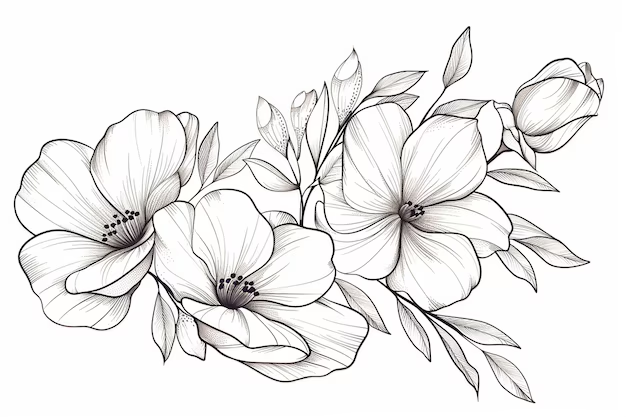introduction to Flower Drawing
Flower drawing is a timeless artistic expression that has captivated artists for centuries. From intricate botanical illustrations to loose, impressionistic sketches, the beauty and diversity of flowers make them an ideal subject for artists of all skill levels. Whether you’re an experienced artist or a beginner eager to explore the world offlower drawing, this guide will provide you with everything you need to know to start your journey. Let’s delve into the world of
History of Flower Drawing
Flower drawing has a rich history that dates back to the early days of botanical illustrations. Artists in the Renaissance period meticulously depicted flowers to document their characteristics for scientific purposes. Over time, the practice evolved into a popular art form, with famous artists like Pierre-Joseph Redouté and Georgia O’Keeffe contributing to its growth. Today, flower drawing is enjoyed by hobbyists and professionals alike, who explore both traditional and contemporary styles.
Tools and Materials for Flower Drawing

Getting the right tools is essential for creating beautiful flower drawings. Here are some basic tools you will need:
- Pencils: Graphite pencils for sketching and adding details.
- Pens and Inks: For outlining and creating bold lines.
- Brushes: Useful for adding watercolor effects.
- Paper: Different textures of paper can enhance your drawing, from smooth for pen drawings to textured for watercolor.
- Colored Pencils, Watercolors, and Markers: For adding color to your drawings.
Types of Flower Drawing Styles
Flower drawing is versatile, and artists can choose from a range of styles depending on their preferences:
- Realistic Flower Detailed and true to life, focusing on accuracy.
- Abstract Flower Drawing: Emphasizes shapes, colors, and forms, often without precise detail.
- Botanical Illustration: Scientific and accurate, often used for educational purposes.
- Sketchy or Loose Flower Drawing: Focuses on the overall impression rather than detail, with quick, expressive strokes.
Getting Started with Flower Drawing
If you’re new to flower , start with some basic principles:
- Understand Shapes: Break down the flower into simple shapes like circles, ovals, and lines.
- Use References: Study real flowers or photos to understand the structure.
- Practice Basic Sketches: Start with simple flowers before moving on to more complex ones.
Step-by-Step Guide to Drawing a Flower
Let’s take you through a simple flower
- Choose Your Flower: Select a flower you like; start with something simple like a daisy or tulip.
- Sketch the Outline: Lightly sketch the basic shape of the flower, focusing on the petals’ arrangement.
- Add Details: Refine the petals, stem, and leaves, adding texture and patterns.
- Shade and Finalize: Add shading to give depth, emphasizing areas where the petals overlap.
How to Draw Flowers with Different Techniques
- Pencil Drawing: Use soft pencils for sketching and shading, hard pencils for detailed lines.
- Watercolor Techniques: Experiment with wet-on-wet and wet-on-dry techniques for varied effects.
- Ink and Pen: Use fine liners for crisp lines or brush pens for more dynamic strokes.
Drawing Different Types of Flowers
Each flower has unique characteristics that require different approaches:
- Roses: Focus on the overlapping petals.
- Sunflowers: Emphasize the central disk and large petals.
- Tulips: Smooth, curved petals that taper to a point.
- Daisies: Simple round petals and a central disk.
- Orchids: Complex shapes, requiring detailed attention.
Common Mistakes in Flower Drawing and How to Avoid Them
Mistakes are part of the learning process. Here are a few to watch out for:
- Overworking: Too much detail can make a drawing look cluttered. Learn to stop at the right time.
- Incorrect Proportions: Observe the flower carefully to keep the proportions accurate.
- Lack of Depth: Use shading to create a three-dimensional effect.
Tips and Tricks for Improving Your Flower Drawings
- Experiment with Different Styles: Try realism, abstract, and other styles to find what resonates.
- Practice Shading and Lighting: Light source awareness can add realism.
- Develop a Unique Style: Regular practice helps in building a distinct artistic voice.
Coloring Your Flower Drawings
- Using Colored Pencils: Build layers for a rich, vibrant effect.
- Blending Techniques: Use blending tools to soften edges and mix colors.
- Markers and Watercolors: Experiment with bold, bright colors for a striking look.
Inspiration for Flower Drawing
Inspiration can come from various sources:
- Photography: Use detailed photos as reference.
- Real Flowers: Visit a botanical garden and sketch live flowers.
- Online Resources: Many websites and platforms offer tutorials and reference images.
Benefits of Flower Drawing as a Hobby
Flower drawing isn’t just about art; it has other benefits:
- Enhances Creativity: Experiment with colors, styles, and compositions.
- Reduces Stress: Drawing can be a therapeutic activity.
- Improves Focus: Paying attention to detail enhances concentration skills.
Advanced Techniques in Flower Drawing
For experienced artists looking to challenge themselves:
- Complex Compositions: Draw bouquets or mixed flower arrangements.
- Layering and Textures: Use different techniques to create textures.
- Backgrounds and Elements: Incorporate other elements like leaves, branches, and insects.
Digital Flower Drawing
Digital tools have expanded the possibilities of
- Software and Apps: Tools like Procreate, Adobe Fresco, and Photoshop.
- Comparison: Digital vs. Traditional drawing – each has its pros and cons.
Flower Drawing for Kids
can be a fun activity for kids:
- Simple Exercises: Draw basic shapes and patterns.
- Educational Value: Learn about different flower species.
- Encouraging Creativity: Allow children to play with colors and designs.
Frequently Asked Questions (FAQs)
Q1: What is the easiest flower to draw?
Simple flowers like daisies or tulips are great for beginners.
Q2: How do I improve my flower drawing skills?
Regular practice, studying real flowers, and learning from tutorials can help.
Q3: What tools do beginners need?
A pencil, eraser, paper, and some colored pencils are sufficient for starters.
Q4: Can I draw flowers without any references?
Yes, but using references helps in understanding real-life structures.
Q5: How can I add more depth to my drawings?
Use shading and highlighting techniques to create a 3D effect.
Q6: What are some good online courses for flower drawing?
Platforms like Udemy and Skillshare offer courses for various skill levels.
Conclusion
is an art form that combines skill, patience, and creativity. With practice and experimentation, anyone can learn to draw beautiful flowers, whether aiming for realistic botanical art or playful, colorful designs. So pick up your tools, find your favorite flower, and start drawing!


